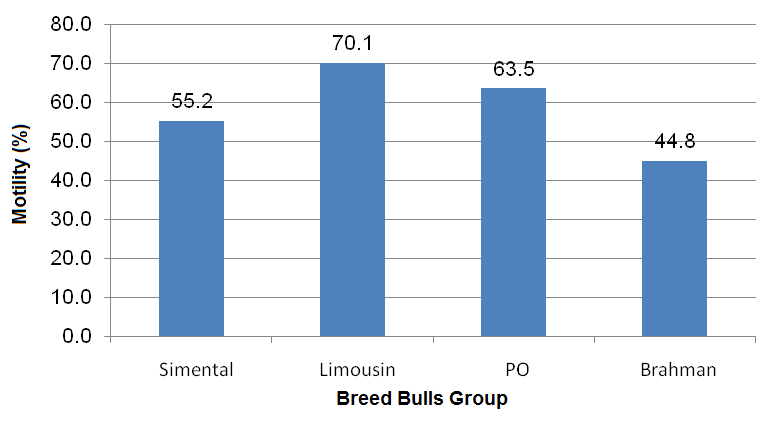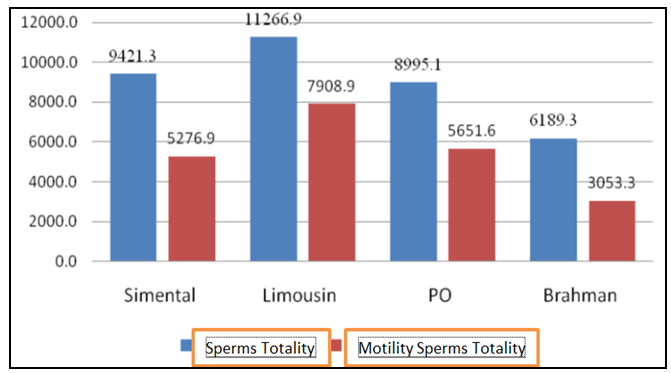-
Paper Information
- Paper Submission
-
Journal Information
- About This Journal
- Editorial Board
- Current Issue
- Archive
- Author Guidelines
- Contact Us
Research in Zoology
p-ISSN: 2325-002X e-ISSN: 2325-0038
2016; 6(1): 8-10
doi:10.5923/j.zoology.20160601.02

Evaluation of Different Breeds of Beef Cattle Bull's Capacity in Producing Frozen Sperms
Abd Al Karim Khalifa Mabrok Zamuna, Trinil Susilawati, Gatot Ciptadi
Faculty of Animal Husbandry, Brawijaya University, Malang, Indonesia
Correspondence to: Abd Al Karim Khalifa Mabrok Zamuna, Faculty of Animal Husbandry, Brawijaya University, Malang, Indonesia.
| Email: |  |
Copyright © 2016 Scientific & Academic Publishing. All Rights Reserved.
This work is licensed under the Creative Commons Attribution International License (CC BY).
http://creativecommons.org/licenses/by/4.0/

Frozen semen production level was specified by quality of fresh semen. Different breeds of beef cattle produce various quality of fresh semen. The aim of this study was to determine differences of frozen sperms production competence of various breed of beef in Artificial Insemination (AI) Center of Ungaran. This study was conducted at Artificial Insemination (AI) Center of Ungaran, Semarang, Central Java, Indonesia. Data collecting was done based on recording data of sperm from 2014 to 2015. Sperm quality and frozen sperm production were observed in Simmental bull, Limousine bull, Brahman bull and Ongole bull. 39 bulls were observed that are 18 Simental, 8 Limousin, 8 PO and 5 Brahman. The method was done by sampling data analysis using Analysis of Variant (ANOVA). The study design was used completely randomized design of sperms production and average production of frozen semen variation between breeds. During 2014 the best sperm production is Limousin bull, but the highest total number of frozen semen produced is Brahman bull. There is no significant difference in the average production of frozen semen among the Limousine cattle, Simental and Brahman, but in the Brahman cattle does. Each individual has the ability to produce spermatozoa with resistance in different freezing processes. The conclusion is sperms production and average production of frozen semen varies between breeds and during 2014 to 2015 the best production is Limousin bulls.
Keywords: Artificial Insemination, Breeds, Frozen sperm, Motility, Sperm
Cite this paper: Abd Al Karim Khalifa Mabrok Zamuna, Trinil Susilawati, Gatot Ciptadi, Evaluation of Different Breeds of Beef Cattle Bull's Capacity in Producing Frozen Sperms, Research in Zoology , Vol. 6 No. 1, 2016, pp. 8-10. doi: 10.5923/j.zoology.20160601.02.
Article Outline
1. Introduction
- Artificial Insemination (AI) in the use of a technological process involving semen collection for the obtaining, processing and deposition of male gametes in the female genitals to fertilize the oocyte, is passing by semen deposition through natural mating. The driving force behind commercial AI is to disseminate superior genes with genetic merit into the population at an affordable cost. The important genetic traits include the rate of muscle production, gain milks, athletic performance, and correct conformation. If AI was done properly, it reduces or eliminates the spread of disease between breeding animals and become the most potential technique devised for the genetic improvement of animals. The main problem is few selected males that produce enough sperm to inseminate thousands of females per year [1].Bull Semen collection was done twice a day, 2 or 3 days per week to harvest more sperm and to freeze on time. The temperature of the Artificial Vagina (AV) and AI is more important than the exert pressure on the penis. Water is used to control it, but final pressure may be adjusted by pumping in air. The temperature inside the AV is near 45°C, but from 38-55°C has been employed [2].Freezing sperms affects physical damage such as plasma membrane and acrosome membrane damage, so at the time of the death of freezing sperm, will occur 20-80% or an average of 50% [3]. Today, Artificial insemination problems in Ungaran is the number of superior males which could accomodate imported sperm product, cannot be processed into frozen sperms because the sperms quality does not meet standards. The Indonesian National Standard (SNI) prescribe the fresh sperms to process has individual motility ≥70% and mass motility of at least 2+. Males which in Artificial Insemination (AI) Center of Ungaran are studs that comes from Australia and nursery Padang Mangatas. Most frozen sperms production in Artificial Insemination (AI) Center of Ungaran was produced by local cattle and import. This study aimed to evaluate the ability of frozen sperms production of various breed beef cattle in Artificial Insemination (AI) Center of Ungaran, Semarang, Central Java, Indonesia. In addition, it will be able to evaluate and address the problems causing a decline of frozen sperm production, in order to increase the production of frozen sperms and cattle breeding programs in the community.
2. Materials and Methods
2.1. Location and Time Schedule
- This study was conducted at Artificial Insemination (AI) Center of Ungaran, Jl. Lt. MT. Haryono No. 53 A. Sidomulyo, Ungaran, Semarang, Central Java, Indonesia. The data collection was conducted on 28-30 January 2015.
2.2. Material Research
- Data were recorded from 2014 to 2015 including sperm quality and frozen sperms production from Simmental cattle, Limousine, Brahman and Ongole. In this study we used four breed cattles: Simental; Limousin; PO; and Brahman. Total number of animal was 39, with details as follows: Simental bull (18) consist of Neptune, Uranus, Mars, Hansa, Sagola, Rowan, Style, Charles, Napitule, Charge, Chanselor, Classic, Tracer, Lucky, Champion, King K, Bullock and Baranang; Limousin Bull (8) consists of Raystine, Chum, Enzo, Stretch, Executive, Tandara, Umberto and Enka; PO Bull (8) consist of Suryolaras, Waluyoseto, Polan, Kempo, Champion, Mighty, Pathol and Dampo; and Brahman Bull (5) consist of Brago, Bramen, Wiguno, Brahmins and Bravo. Semen productions were observed from January to December 2014.
2.3. Research Design and Sampling
- Research design and sampling were purposive method sampling by case study. The data were collected from secondary data in Artificial Insemination (AI) Center of Ungaran, Semarang, Central Java, Indonesia.
2.4. Statistical Analysis
- The data were processed using statistical analysis of variant (ANOVA), to determine the difference variables that did not have a relationship of observed variables with a significance level (0.05 or 5%). The design of this study was using planning random in different breeds.
3. Result and Discussion
3.1. Volume of Fresh Semen
- The volume of semen was produced by a cattle could be different from others. Therefore it is necessary to evaluate the volume of semen. The average volume of semen was significantly (P < 0.05) different between bulls. Average semen volume of Limousin bull was the highest (7.2 ± 1.3 ml), followed by Simental bull (6.9 ± 1.6 ml), PO bull (6.1 ± 1.2 ml) and the lowest was Brahman bull (4.2 ± 1.8 ml). Ax el al. (2008) explained that the volume of cattle semen per ejaculation could be affected by factors including age and frequency of semen collection. Limousine bulls and Simental bulls show greater volume than PO and Brahman bulls. Nonetheless, PO bulls produce average yield of normal volume, while the Brahman bull volume is normal (Figure 1). Previous study stated that normal semen volume produced by bull ranged from 5-8 ml per ejaculation semen volume of four different breed bulls [4].
 | Figure 1. Volume of normal semen produced by Simental, Limousin, PO and Brahman bulls |
3.1.1. Percentage of Individual Sperm Motility of Four Different Breed Bulls
- Average of total sperms and total sperms motility on Simental bulls were 9421.3 ± 2418.3 and 5276.9 ± 31301; Limousin bulls were 11266.9 ± 1159.6 and 7908.9 ± 38512; PO bulls were 8995.1 ± 2860.8 and 5651.6 ± 24184; Brahman bulls were 6189.3 ± 22.6 and 3053.3 ± 43566 (Figure 3). Different productivity of the two nations bull per month can be influenced by many factors, consists of genetic, age, body weight, feed and environmental conditions [5]. The statistical analysis result show there is no significant different between cattles in parameter percentage of motility sperms (P > 0.05). It could be assumed that there is no significant difference in volume between the cattle of local and non-local types. This is consistent with the results of previous research which stated that the production of sperms among the cattle of Simmental, Limousin and Brahman were not significantly different [5].
 | Figure 2. Percentage of motility sperm from Simental, Limousin, PO and Brahman bulls |
3.1.2. Total Sperms and Total Sperms Motility of Various Bull
- Average of total sperms and total sperms motility on Simental bulls were 9421.3 ± 2418.3 and 5276.9 ± 31301; Limousin bulls were 11266.9 ± 1159.6 and 7908.9 ± 38512; PO bulls were 8995.1 ± 2860.8 and 5651.6 ± 24184; Brahman bulls were 6189.3 ± 22.6 and 3053.3 ± 43566 (Figure 3). Different productivity of the two nations bull per month can be influenced by many factors, consists of genetic, age, body weight, feed and environmental conditions [5]. The statistical analysis result show there is no significant different between cattles in parameter percentage of motility sperms (P > 0.05). It could be assumed that there is no significant difference in volume between the cattle of local and non-local types. This is consistent with the results of previous research which stated that the production of sperms among the cattle of Simmental, Limousin and Brahman were not significantly different [5].
 | Figure 3. Average of sperm total and motility sperm from Simental, Limousin, PO and Brahma bulls |
3.1.3. The Average Production of Straw per Days
- Semen frozen production ability is influenced by several factors, including volume of fresh semen, concentration and motility. Other study stated that concentrations of spermatozoa is one factor that used as a determinant level of dilution to perform on the sperms production process [6]. Average productions of straw per days on Simental, Limousin, PO and Brahman were 274.1 ± 123.8; 301.8 ± 57.9; 265.4 ± 135.8 and 141.0 ± 113.2, respectively (Figure 4). There is no significant differences between the various breeds of cattle at dose parameters (P > 0.05).
 | Figure 4. Average production of straw in Simental, Limousin, PO and Brahman bulls |
4. Conclusions
- Sperms production and average production of frozen semen varies between breeds and the best production is Limousin bull, but the total number of frozen semen produced is Brahman bull. There is no significant difference in the average production of frozen semen among the Limousine, Simental, PO and Brahman bulls. Each individual breed bull has the ability to produce spermatozoa with resistance in different freezing processes.
 Abstract
Abstract Reference
Reference Full-Text PDF
Full-Text PDF Full-text HTML
Full-text HTML